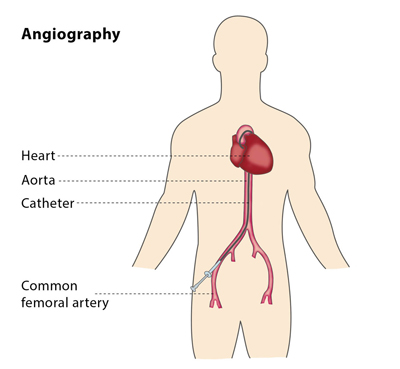Angiography is the process of taking pictures of the inside of blood vessels. The picture itself is called an angiogram. The angiogram allows your doctor to check the inside of a blood vessel to see if it is narrowed or blocked.
Any blood vessel in the body may become narrowed, enlarged, or blocked. Angiograms of the carotid arteries, which travel up each side of the neck to the brain, can show whether a stroke is likely because the arteries are narrowed or blocked. Angiograms can also show a tumor in the brain. Pictures of the coronary arteries, which supply the heart muscle with blood, may show narrowing that make a heart attack likely or a complete blockage from one that has already occurred.
The aorta is the large artery that leads from the heart to the rest of the body. Angiograms of the aorta can show if it is blocked or if there is an aneurysm, a weakened, bulging area in the artery wall.
Angiograms also can show narrowing of the arteries to the legs, which may cause pain when walking. Angiograms of veins can show the presence of blood clots that may become dangerous.

An angiogram rarely takes longer than an hour and may be an outpatient procedure. You should not eat anything for 4 hours before the procedure. A special dye that shows up in an x-ray is injected into an artery or a vein through a needle or a small tube called a cannula. As the dye flows in the blood vessel, an x-ray machine rapidly takes a series of pictures. The pictures are taken so fast that they form a movie of the progress of the dye. When the pictures are developed, your doctor will look at them. He or she may even use a computer program to make the pictures plainer. After the angiogram you may be kept in an observation area until any risk of bleeding is past. Then you may resume your usual activities.
You will feel very little discomfort. You will be given a shot to numb the skin over the blood vessel before the dye is injected. Immediately after the injection of dye you may feel a warm or hot flush spreading over your entire body. This warm flush lasts only a few seconds.
Angiography provides information that your doctor cannot get any other way. The best treatment for your condition can then be started.
An angiogram is generally a common and safe procedure, but complications can occur. Although the dyes used are designed to be safe, some people are allergic or sensitive to them. This rarely happens, but when it does, the person may develop breathing problems or a drop in blood pressure. If you have kidney disease, an angiogram may make the disease worse. Your doctor will fully explain the risks of the test and will not recommend it unless it is needed.
After an angiogram, call your doctor if you have bleeding, pain, or increased swelling in the area where the dye was injected.
